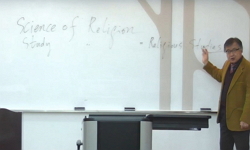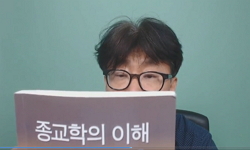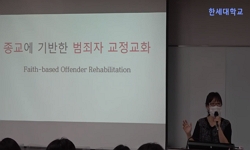The Classification of the Five Subdivided Teachings in the Huayan appears in the Hwaeomgyeong-Mundap, presumably a transcript of Uisang' lecture. It's overall sketch was at first presented in the course of explaining the Five Essentials of Teaching in...
http://chineseinput.net/에서 pinyin(병음)방식으로 중국어를 변환할 수 있습니다.
변환된 중국어를 복사하여 사용하시면 됩니다.
- 中文 을 입력하시려면 zhongwen을 입력하시고 space를누르시면됩니다.
- 北京 을 입력하시려면 beijing을 입력하시고 space를 누르시면 됩니다.
https://www.riss.kr/link?id=A104237357
-
저자
장진영 (원광대학교)
- 발행기관
- 학술지명
- 권호사항
-
발행연도
2009
-
작성언어
Korean
-
주제어
Hwaeomgyeong-Mundap ; Uisang ; Zhiyan ; The Five Essentials of Teaching ; The Classification of the Five Teachings ; Perfect Teaching ; Sudden Teaching ; Elementary Teaching ; Gradual Teaching ; 『화엄경문답』 ; 의상 ; 지엄 ; 오종교체 ; 오교판 ; 원교 ; 돈교 ; 종교 ; 초교 ; 점교. ; Hwaeomgyeong-Mundap ; Uisang ; Zhiyan ; The Five Essentials of Teaching ; The Classification of the Five Teachings ; Perfect Teaching ; Sudden Teaching ; Elementary Teaching ; Gradual Teaching
-
등재정보
KCI등재
-
자료형태
학술저널
-
수록면
711-756(46쪽)
-
KCI 피인용횟수
1
- 제공처
-
0
상세조회 -
0
다운로드
부가정보
다국어 초록 (Multilingual Abstract)
The Classification of the Five Subdivided Teachings in the Huayan appears in the Hwaeomgyeong-Mundap, presumably a transcript of Uisang' lecture. It's overall sketch was at first presented in the course of explaining the Five Essentials of Teaching in the SuXuan-Ji earlier written by Zhiyan. The case of using the subdivided five teachings is rarely found in the other texts than Zhiyan's Kongmu-zhang where Zhiyan introduces the those to explain the tathatā. I make a comparative study on the five teachings in Mundap and Kongmu-zhang. The details of the subdivided five teachings are elaborated in the Gradual teaching.
The division of the Beginning and the Ending seems to be the influences of the new translation of the Scriptures and related Canons, especially in terms of the understanding of tathatā. The essence of the teaching of the Beginning is the sūnyatā but includes the consciousness-only theory of the Dharmalakṣaṇa in the Beginning. It doesn't fall within the Final because of not relying on the tathatāgatha and dosen't go into the Ending of the Elementary teaching because of revealing sūnyatā
The Beginning and the Ending of the Final teaching, and of the Sudden teaching, adopts the explanation of three steps of the Speaking of Huiyuan about the Non-dual Dharma in the Vimalakīrti Sutra. The Final teaching and the Sudden teaching are respectively divided into the Verbal and Non-verbal teaching, and Speakable and Non-speakable teaching, in which the Sudden teaching takes place in the ultimate teaching of the Final teachings. This seems corresponding to the Sudden teaching of the Five teachings of Uisang. Only in the Mundap, the Sudden teaching is closer to the Final teaching of the Three Vehicles rather than that of the Perfect teaching of the One Vehicle.
It seems that the types of the Beginning and the Ending in the Final teaching was developed in relation to the division of the true consciousness and altered false consciousness. They share the meaning of non-sūnyatā because both arise on the strength of tathāgatagarbha including the Old school of Consciousness-only in China. Only they individually divide the Beginning and the Ending of the Final teaching due to the difference of the method of development.
Finally it seem that it is impossible to divide each other throughout the Essential of Teaching from the Final Teaching to the Perfect Teaching. Therefore the viewpoint of dividing between of the Final Teaching and the Sudden Teachings discover from the view of the Verb on the Principle without differentiation and the classification between the Three Vehicle and the One Vehicle is due to whether getting the standpoint of One Vehicle or not.
국문 초록 (Abstract)
의상의 강의록으로 추정되고 있는 『화엄경문답』에는 좀 더 세분화된 5교판이 사용되고 있다. 그것은 지엄의 초기 저작인 『수현기』에서 언급된 5종 교체를 5교판으로 설명한 것이다. 이...
의상의 강의록으로 추정되고 있는 『화엄경문답』에는 좀 더 세분화된 5교판이 사용되고 있다. 그것은 지엄의 초기 저작인 『수현기』에서 언급된 5종 교체를 5교판으로 설명한 것이다. 이런 유형은 적용한 사례를 찾아보기가 쉽지 않다. 다만 이미 지엄의 『공목장』에 이를 진여의 대한 설명에 적용한 사례가 있어 이를 비교 검토하였다. 5교판의 세분화된 모습은 점교문에서만 나타나고 있다.
초교문에서 시문과 종문을 나눈 계기는 신역 경론의 진여에 대한 이해에서 비롯된 것으로 초교는 본래 空義를 본질로 하는데 시문에 법상유식의 내용을 소속시키고 있다. 그 의지가 眞識이 아닌 妄識이기 때문에 종교에 속하지 못한 것이며, 그 밝힌 진여가 공의에 미치지 못하기 때문에 초교 중에서도 시문에 속한 것이다.
종교문에서 시문과 종문은 돈교문과 함께 봐야 하는데, 그것이 『유마경』의 不二法門에 대한 혜원의 說에 대한 3단계의 설명에 기인하기 때문이다. 이로써 종교문과 돈교문은 言(가설)과 黙(불가설)으로 구분되고 돈교의 교체도 명확해졌으며, 돈교의 위치도 삼승의 궁극의 지위를 차지하게 되었다. 의상은 돈교를 5교판의 돈교로 보았는데, 『문답』도 이를 따르고 있다고 보며, 다만 돈교를 일승원교보다 삼승의 종교에 더 밀접하게 파악한 것으로 판단된다. 종교문 내에서 시문과 종문의 구분은 구유식내에 진식(리야유식)과 망식(의식유식)의 전개방식에서 기인한 것으로 파악되었다. 비록 종교의 시문에 속한 망식은 여래장진식을 의지로 하기 때문에 초교의 시문에 속하는 신유식의 망식(아뢰야식)과는 구분된다. 마지막으로 종교부터 원교까지 표면상 그 교체를 공유하므로 교체만으로는 서로 구분할 수 없게 되었다. 이에 종교와 돈교는 둘 다 무분별의 理의 입장에서 가설과 불가설의 여부에 따라 구분하게 되었고, 삼승(종교‧돈교)과 일승(원교)과의 구분은 일승에 대한 안목을 갖추었는지 여부로 판단해야 할 것이다.
참고문헌 (Reference)
1 織田顯祐, "초기화엄사상사" 불교시대사 2007
2 전해주, "의상화엄사상사연구" 민족사 1992
3 박태원, "의상의 화엄사상" 울산대학교 출판부 2005
4 최연식, "의상연구의 현황과 과제" 19 : 2002
5 김상현, "신라의 사상과 문화" 一志社 1999
6 "華嚴經問答"
7 "華嚴經內章門等雜孔目章"
8 吉津宜英, "華嚴禪の思想史的硏究" 大東出版社 1985
9 坂本幸男, "華嚴敎學の硏究" 平樂寺書店 1956
10 石井公成, "華嚴思想の硏究" 春秋社 1996
1 織田顯祐, "초기화엄사상사" 불교시대사 2007
2 전해주, "의상화엄사상사연구" 민족사 1992
3 박태원, "의상의 화엄사상" 울산대학교 출판부 2005
4 최연식, "의상연구의 현황과 과제" 19 : 2002
5 김상현, "신라의 사상과 문화" 一志社 1999
6 "華嚴經問答"
7 "華嚴經內章門等雜孔目章"
8 吉津宜英, "華嚴禪の思想史的硏究" 大東出版社 1985
9 坂本幸男, "華嚴敎學の硏究" 平樂寺書店 1956
10 石井公成, "華嚴思想の硏究" 春秋社 1996
11 "華嚴一乘法界圖"
12 "華嚴一乘教義分齊章"
13 吉津宜英, "華嚴一乘思想の硏究" 大東出版社 1991
14 吉津宜英, "旧来成仏について-性起思想硏究の一視点" 32 (32): 1983
15 佐藤厚, "新羅高麗華嚴敎學の硏究-均如一乘法界圖圓通記を中心として" 東洋大學 1997
16 "大方廣佛華嚴經搜玄分齊通智方軌"
17 "大乘義章"
18 大竹晋, "唯識說を中心とした初期華嚴敎學の硏究ー智儼‧義湘から法藏へ" 大藏出版 2007
19 木村淸孝, "初期中國華嚴思想の硏究" 春秋社 1977
20 박태원, "『화엄경문답』과 의상의 일승・삼승론" 86 : 1997
21 김상현, "『錐洞記』와 그 이본 『화엄경문답』" 84 : 1996
동일학술지(권/호) 다른 논문
-
- 한국선학회
- 김경집
- 2009
- KCI등재
-
중국근현대 불교와 유학의 논쟁 - 印順과 熊十力 의 논쟁을 중심으로
- 한국선학회
- 김제란
- 2009
- KCI등재
-
- 한국선학회
- 유정엽
- 2009
- KCI등재
-
- 한국선학회
- 고연미
- 2009
- KCI등재
분석정보
인용정보 인용지수 설명보기
학술지 이력
| 연월일 | 이력구분 | 이력상세 | 등재구분 |
|---|---|---|---|
| 2028 | 평가예정 | 재인증평가 신청대상 (재인증) | |
| 2022-01-01 | 평가 | 등재학술지 유지 (재인증) |  |
| 2019-01-01 | 평가 | 등재학술지 유지 (계속평가) |  |
| 2016-04-29 | 학술지명변경 | 한글명 : 韓國禪學(한국선학) -> 禪學(선학) |  |
| 2016-02-04 | 학회명변경 | 영문명 : Korean Seon Studies -> The Korean Society for Seon Studies |  |
| 2016-02-03 | 학술지명변경 | 외국어명 : Journal of Korean Seon Studies -> Journal of Seon Studies |  |
| 2016-01-01 | 평가 | 등재학술지 유지 (계속평가) |  |
| 2012-01-01 | 평가 | 등재 1차 FAIL (등재유지) |  |
| 2009-01-01 | 평가 | 등재학술지 선정 (등재후보2차) |  |
| 2008-01-01 | 평가 | 등재후보 1차 PASS (등재후보1차) |  |
| 2007-01-01 | 평가 | 등재후보학술지 유지 (등재후보1차) |  |
| 2005-01-01 | 평가 | 등재후보학술지 선정 (신규평가) |  |
학술지 인용정보
| 기준연도 | WOS-KCI 통합IF(2년) | KCIF(2년) | KCIF(3년) |
|---|---|---|---|
| 2016 | 0.68 | 0.68 | 0.6 |
| KCIF(4년) | KCIF(5년) | 중심성지수(3년) | 즉시성지수 |
| 0.59 | 0.56 | 1.142 | 0.19 |




 KCI
KCI






